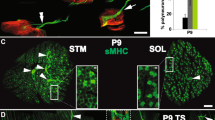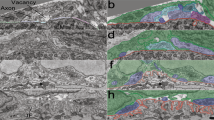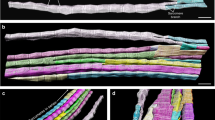Abstract
The synaptic connections among the cells of the vertebrate nervous system undergo extensive rearrangements early in development1,2. During their initial growth, neurones apparently form synaptic connections with an excessive number of targets, later retracting a portion of these synapses in establishing the adult neural circuits. Because of the profound effects which experience has upon the developing nervous system3, a question of considerable interest has been the role which the functional use of these developing synapses might play in determining the final pattern of connectivity. At the neuromuscular junction the early changes in synaptic connections are well documented, and here questions about the importance of function can be relatively easily addressed. Mammalian skeletal muscle fibres experience a perinatal period of synapse elimination so that all but one of several synapses formed on each muscle fibre are lost4–6. This synapse elimination is sensitive to alterations of neuromuscular use or activity. Reduction of muscle use by tenotomy7,8 or by paralysis of the muscle with drugs blocking nerve impulse conduction9 or neuromuscular transmission10 delays or even prevents synapse loss, while increased use produced by stimulation of the muscle nerve11 apparently accelerates the rate at which synapses are lost. I report here a further examination of the role of neuromuscular activity in synapse elimination. I show that chronic neuromuscular stimulation accelerates synapse elimination but that this acceleration is dependent on the temporal pattern in which the stimuli are presented: brief stimulus trains containing 100 Hz bursts of stimuli produce this acceleration whereas the same number of stimuli presented continuously at 1 Hz do not. Furthermore, the 100 Hz activity pattern which is effective in altering synapse elimination also alters two other muscle properties: the sensitivity of the muscle fibres to acetylcholine and the ‘speed’ of muscle contractions. These findings suggest that the ability of muscle fibres to maintain more than one nerve terminal, like other muscle properties, is sensitive to the pattern of muscle use rather than just the total amount of use.
This is a preview of subscription content, access via your institution
Access options
Subscribe to this journal
Receive 51 print issues and online access
$199.00 per year
only $3.90 per issue
Buy this article
- Purchase on Springer Link
- Instant access to full article PDF
Prices may be subject to local taxes which are calculated during checkout
Similar content being viewed by others
References
Purves, D. & Lichtman, J. W. Science 210, 153–157 (1980).
Cowan, M. W. in Development in the Nervous System (eds Garrod, D. R. & Feldman, D. J.) (Cambridge University Press, 1981).
Harris, W. A. A. Rev. Physiol. 43, 689–710 (1981).
Redfern, P. A. J. Physiol., Lond. 209, 701–709 (1970).
Bennett, M. R. & Pettigrew, A. G. J. Physiol., Lond. 241, 515–545 (1974).
Brown, M. C., Jansen, J. K. S. & Van Essen, D. J. Physiol., Lond. 261, 387–422 (1976).
Benoit, P. & Changeux, J.-P. Brain Res. 99, 354–358 (1975).
Riley, D. A. Brain Res. 143, 162–167 (1978).
Thompson, W., Kuffler, D. P. & Jansen, J. K. S. Neuroscience 4, 271–281 (1979).
Brown, M. C., Holland, R. L. & Hopkins, W. G. J. Physiol., Lond. 318, 355–364 (1981).
O'Brien, R. A. D., Östberg, A. J. C. & Vrbová, G. J. Physiol., Lond. 282, 571–582 (1978).
Weber, E. D. & Stelzner, D. J. Brain Res. 125, 241–255 (1977).
Hall, W. G. Science 190, 1313–1315 (1975).
Hall, W. G. Science 205, 206–209 (1979).
Thompson, W. & Jansen, J. K. S. Neuroscience 2, 523–535 (1977).
Lømo, T. & Westgaard, R. H. J. Physiol., Lond. 252, 603–626 (1975).
Diamond, J. & Miledi, R. J. Physiol., Lond. 162, 393–408 (1962).
Lømo, T., Westgaard, R. H. & Dahl, H. A. Proc. R. Soc. B187, 99–103 (1974).
Close, R. J. Physiol., Lond. 173, 74–95 (1964).
Linden, D. C. & Fambrough, D. M. Neuroscience 4, 527–538 (1979).
Ramirez, B. U. & Pette, D. FEBS Lett. 49, 188–190 (1974).
Streter, F. A., Gergely, J., Salmons, S. & Romanul, F. Nature new Biol. 241, 17–19 (1973).
Purves, D. in Function and Formation of Neural Systems (ed. Stent, G. S.) 21–49 (Dahlem Konferenzen, Berlin, 1977).
Jansen, J. K. S., Thompson, W. & Kuffler, D. P. Prog. Brain Res. 48, 3–18 (1978).
Author information
Authors and Affiliations
Rights and permissions
About this article
Cite this article
Thompson, W. Synapse elimination in neonatal rat muscle is sensitive to pattern of muscle use. Nature 302, 614–616 (1983). https://doi.org/10.1038/302614a0
Received:
Accepted:
Issue Date:
DOI: https://doi.org/10.1038/302614a0
This article is cited by
-
Fully rubbery synaptic transistors made out of all-organic materials for elastic neurological electronic skin
Nano Research (2022)
-
Differences in the constituent fiber types contribute to the intermuscular variation in the timing of the developmental synapse elimination
Scientific Reports (2019)
-
Terminal Schwann cell and vacant site mediated synapse elimination at developing neuromuscular junctions
Scientific Reports (2019)
-
Pattern and not magnitude of neural activity determines dendritic spine stability in awake mice
Nature Neuroscience (2012)
-
Functional recovery improvement is related to aberrant reinnervation trimming. A comparative study using fresh or predegenerated nerve grafts
Acta Neuropathologica (2006)
Comments
By submitting a comment you agree to abide by our Terms and Community Guidelines. If you find something abusive or that does not comply with our terms or guidelines please flag it as inappropriate.



